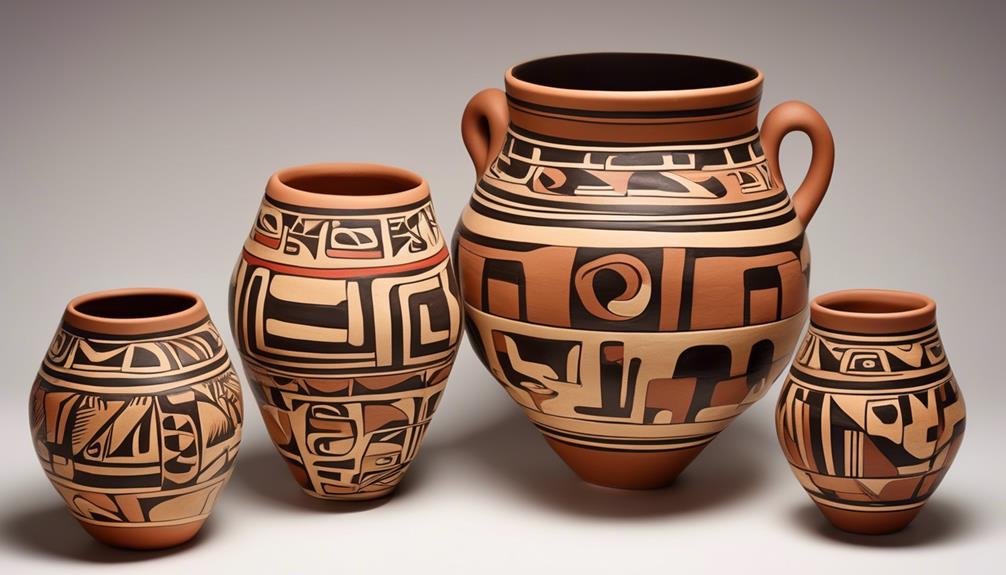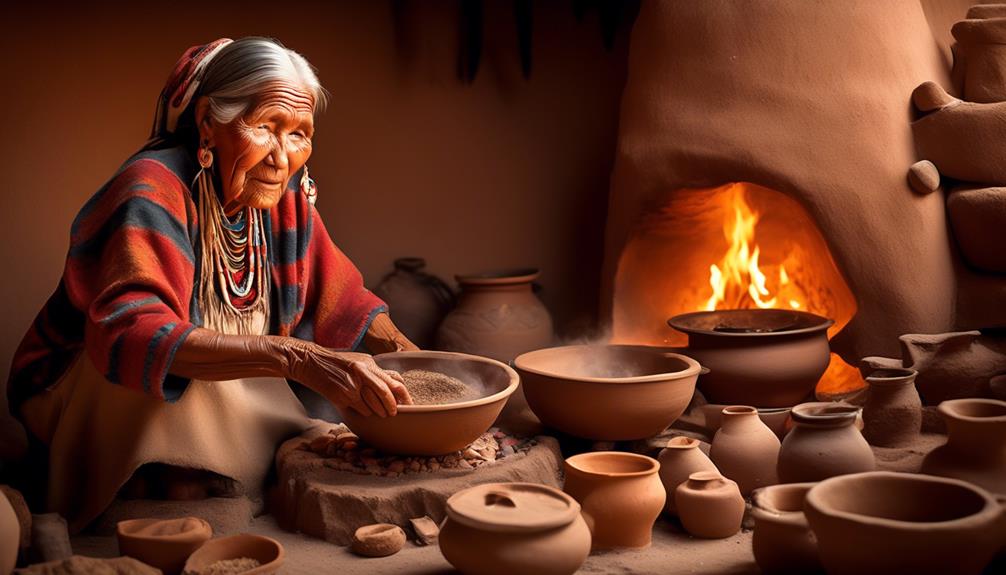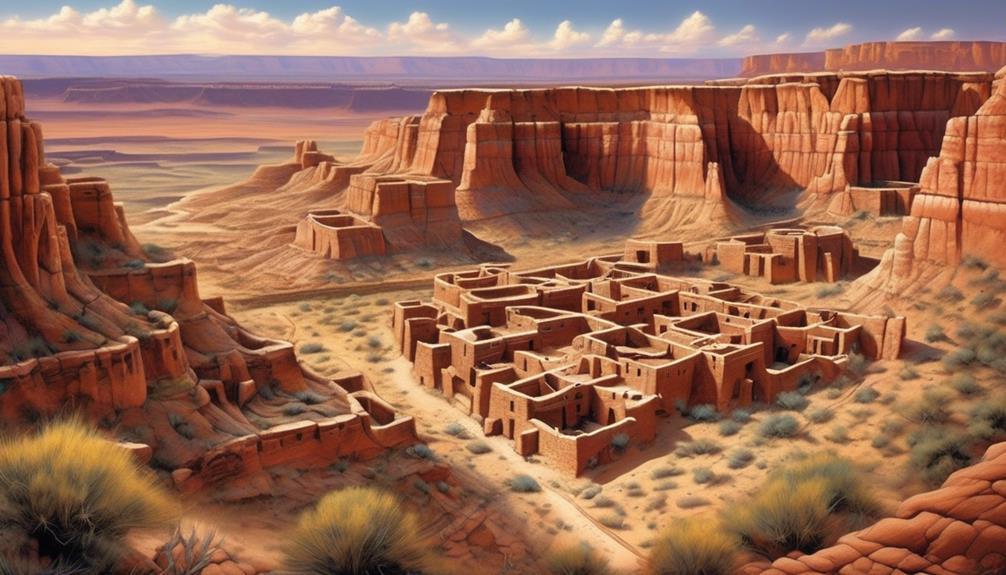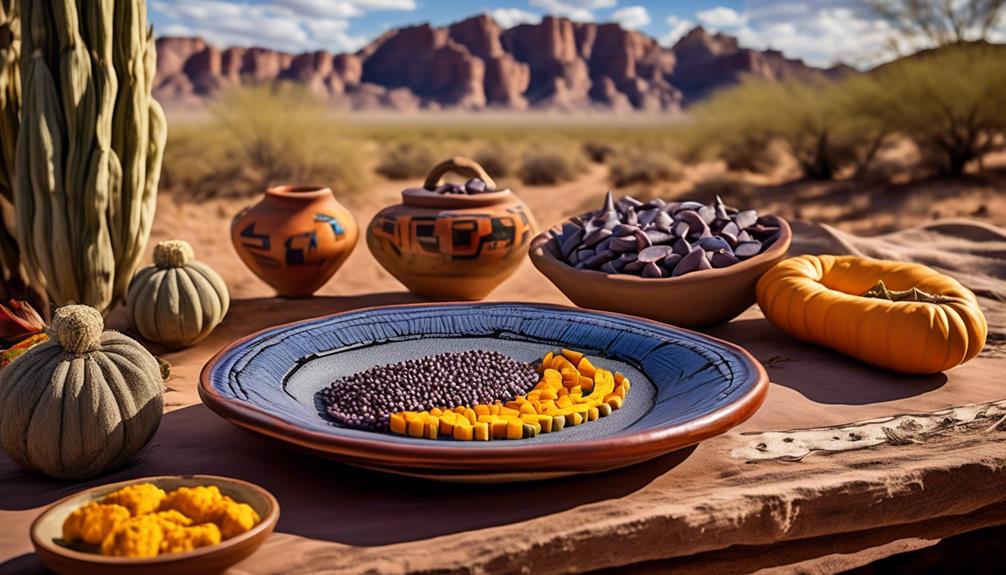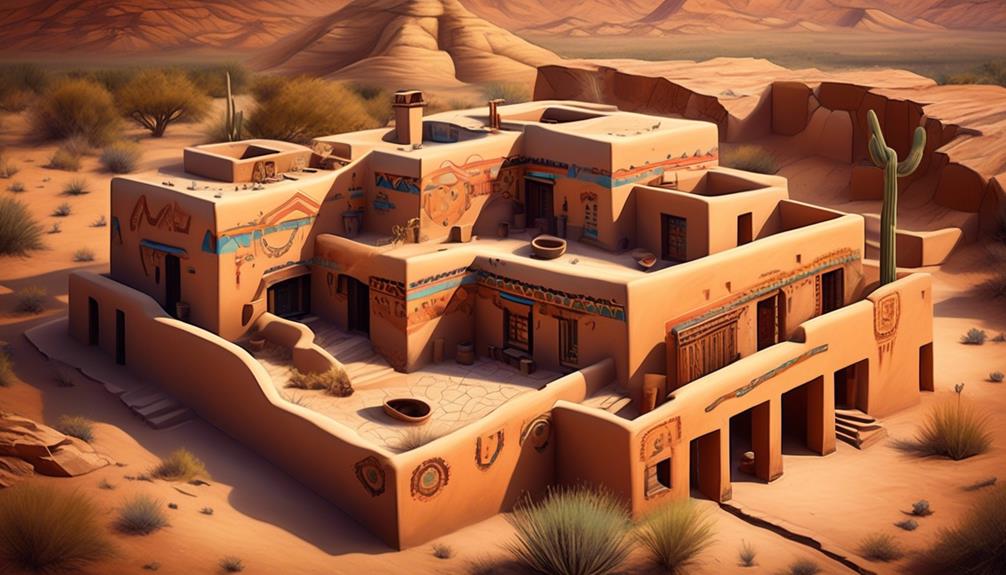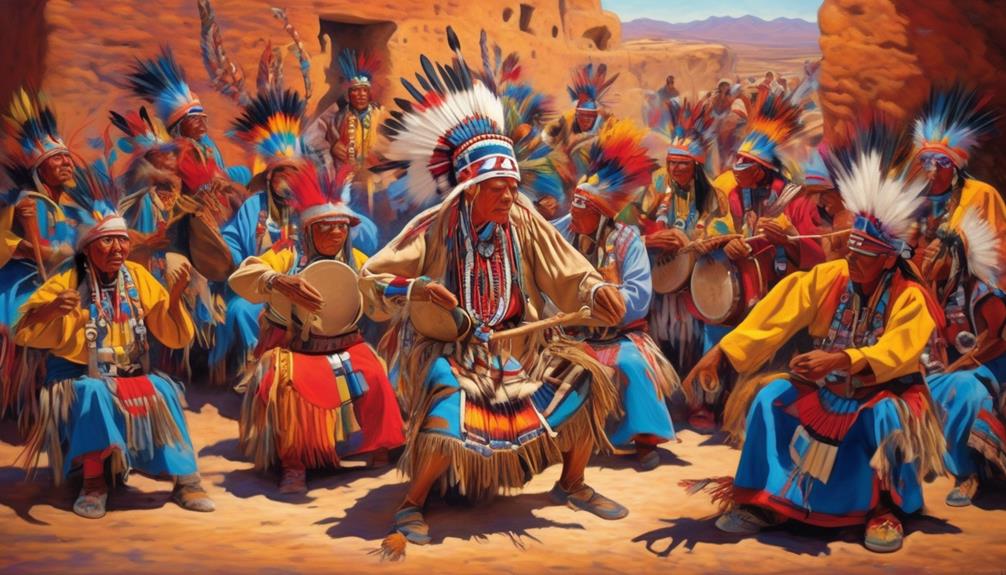Exploring the intricate tapestry of Hopi culture reveals a fascinating array of expertly crafted items.
From the intricately designed pottery and ceramics that not only served practical purposes but also told stories of their beliefs and traditions, to the meticulously crafted Kachina dolls that held deep spiritual significance, the Hopi people were artisans of great skill and reverence.
But what other treasures did their hands bring to life?
What secrets lie within the weavings of their basketry and textiles, and what mysteries do their ceremonial masks hold?
These are the questions that invite us to explore the rich heritage of the Hopi tribe and the remarkable objects they created.
Key Takeaways
- The Hopi tribe crafts pottery and ceramics that showcase their cultural heritage and artistic prowess, using unique firing techniques and meticulous glazing processes with natural pigments.
- Kachina dolls are hand-carved from cottonwood roots and adorned with natural pigments and intricate patterns, serving as symbolic representations of ancestral spirits and deities.
- Basketry and weaving techniques, such as coiling and plaiting, are used by the Hopi tribe to create intricate patterns and designs that convey symbolic meanings.
- Traditional clothing and textiles reflect Hopi cultural heritage and artistic expression, with decorative motifs carrying cultural and spiritual meanings and skilled craftsmanship representing cultural identity.
Pottery and Ceramics
Pottery and ceramics are intricately crafted by the Hopi tribe, showcasing their rich cultural heritage and artistic prowess.
The Hopi people have developed unique firing techniques to create their pottery, using outdoor firing pits and carefully controlling the temperature to achieve the desired strength and color. This traditional method imparts a distinct earthy quality to their pottery, connecting each piece to the land from which it's formed.
Furthermore, the application of glaze is a meticulous process, with the Hopi employing natural pigments to achieve vibrant hues and intricate designs that reflect their deep connection to nature.
Symbolism and artistic styles are integral to Hopi pottery and ceramics. Each piece is imbued with symbolic meaning, often portraying elements of Hopi mythology and spiritual beliefs.
The artistic styles vary among different Hopi villages, with each community contributing its own distinct motifs and patterns to the overall tradition. Through their pottery and ceramics, the Hopi people express their reverence for the natural world and their profound spiritual connection to their ancestral lands.
Kachina Dolls
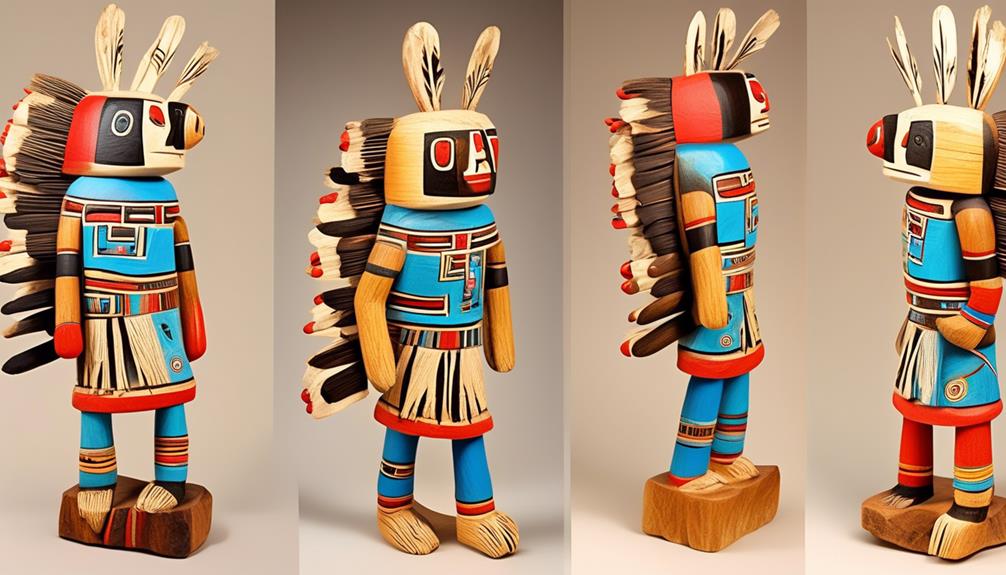
The symbolic representations and cultural significance of Kachina dolls are deeply intertwined with the artistic traditions of the Hopi tribe, reflecting their spiritual beliefs and connection to the natural world. Kachina doll symbolism plays a pivotal role in Hopi ceremonies, representing ancestral spirits and embodying various deities from their religious pantheon. These meticulously crafted dolls aren't mere toys but are imbued with profound spiritual meaning, serving as educational tools for teaching tribal history, traditions, and religious concepts to younger generations.
The craftsmanship techniques employed in creating Kachina dolls are a testament to the Hopi artisans' skill and cultural reverence. Each doll is hand-carved from cottonwood roots, with the utmost attention to detail given to the carving and painting process. Natural pigments from plants and minerals are used to adorn the dolls, with intricate patterns and symbols that hold specific meanings within Hopi cosmology. The craftsmanship reflects a deep respect for the materials and traditions, ensuring that each doll preserves the cultural heritage and spiritual essence of the Hopi tribe.
Basketry and Weaving
Using time-honored techniques and natural materials, the Hopi tribe showcases their intricate artistry and cultural heritage through the rich tradition of basketry and weaving. Basketry plays a significant role in the daily lives and ceremonies of the Hopi people. The baskets are crafted using a variety of techniques, including coiling, plaiting, and wicker weaving. These techniques allow for the creation of diverse shapes and sizes, from shallow trays to large storage containers. The materials used for basket weaving range from willow and devil's claw to yucca and sumac. Each material imparts unique qualities to the finished product, with intricate patterns and designs often incorporated to convey symbolic meanings.
Weaving, another integral part of Hopi craftsmanship, is primarily focused on textiles. The Hopi people are known for their distinct weaving patterns, which are often passed down through generations. Traditional looms are used to create beautifully patterned textiles, including blankets, sashes, and ceremonial attire. These intricate patterns are not only visually stunning but also hold deep cultural significance, often reflecting stories, beliefs, and the natural world. The art of basketry and weaving among the Hopi tribe serves as a testament to their enduring cultural traditions and artistic excellence.
| Basketry Techniques | Weaving Patterns |
|---|---|
| Coiling | Distinct patterns |
| Plaiting | Symbolic meanings |
| Wicker weaving | Cultural significance |
Traditional Clothing and Textiles
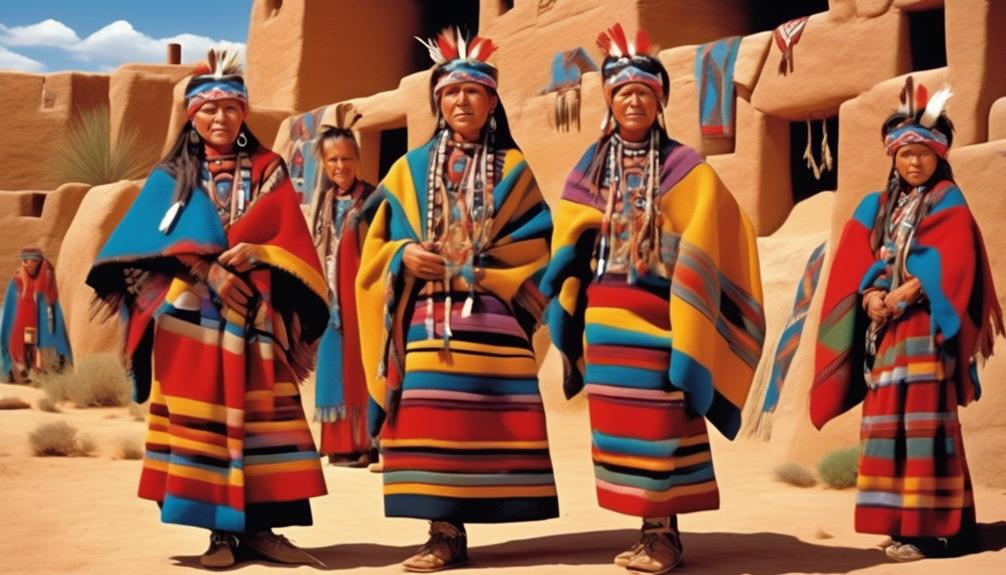
How do traditional clothing and textiles reflect the cultural heritage and artistic expression of the Hopi tribe?
The traditional clothing and textiles of the Hopi tribe are a testament to their rich cultural heritage and artistic expression. Decorative motifs play a significant role in Hopi textiles, with each symbol carrying deep cultural and spiritual meanings. These motifs often represent elements from the natural world, such as animals, plants, and celestial bodies, reflecting the tribe's close connection to the environment and their spiritual beliefs.
Additionally, natural dyes are extensively used in creating Hopi textiles, showcasing the tribe's deep understanding of the natural resources around them. The process of gathering and preparing these dyes has been passed down through generations, highlighting the importance of traditional knowledge and practices within the tribe.
The intricate designs and skilled craftsmanship found in traditional Hopi clothing and textiles serve as a visual representation of the tribe's cultural identity. Each garment and textile is a reflection of the Hopi people's values, traditions, and artistic prowess, encapsulating the essence of their heritage for generations to come.
Ceremonial Masks
Crafted with intricate detail and deep spiritual significance, ceremonial masks hold a revered place in the cultural traditions of the Hopi tribe. These masks are vital components of religious ceremonies and symbolize various deities, ancestral spirits, and natural elements. The artistic techniques used in creating these masks are passed down through generations, emphasizing precision and attention to detail. Symbolic meanings are woven into every aspect of the mask, from the choice of colors to the expressions depicted.
| Symbolic Meanings | Artistic Techniques |
|---|---|
| Sun | Carved from cottonwood root and adorned with feathers and paint, representing the Sun Spirit, a prominent deity in Hopi mythology. |
| Katsina | Intricately designed using a combination of painting and carving, portraying Katsinam, ancestral spirits believed to visit the Hopi during ceremonies. |
| Eagle | Crafted with feathers and intricate beadwork, symbolizing the powerful and revered Eagle Spirit, a significant figure in Hopi spirituality. |
The masks serve as a visual representation of the tribe's rich cultural heritage and spiritual beliefs, offering a glimpse into the profound connection between the Hopi people and the natural and supernatural world.
Frequently Asked Questions
How Did the Hopi Tribe Use Their Pottery and Ceramics in Everyday Life?
We used our pottery with intricate designs to store water and food, preserving it for daily use. Ceramics were essential in our daily life, serving as cooking vessels and offering spiritual significance in rituals.
Our pottery and ceramics reflected our cultural values and stories, passed down through generations. The intricate designs and craftsmanship of our pottery and ceramics were a vital part of our everyday lives, connecting us to our traditions and heritage.
What Is the Significance of Kachina Dolls in Hopi Culture and How Are They Traditionally Made?
Kachina dolls hold immense significance in Hopi culture. They're crafted through a meticulous making process, with each step carrying deep cultural representation and symbolism.
The dolls serve as messengers between the spiritual and physical worlds, embodying various deities and ancestral spirits.
Traditionally made by skilled artisans, these dolls are revered for their role in ceremonies and rituals, symbolizing the Hopi people's connection to their heritage and spiritual beliefs.
What Are Some Specific Uses for the Baskets and Weavings Created by the Hopi Tribe?
We use baskets for storing and carrying food, and for ceremonial purposes. Our weaving techniques are passed down through generations, creating traditional clothing and intricate textile designs.
The baskets and weavings represent our cultural identity and are integral to our daily lives and spiritual practices. The artistry and functionality of these items reflect the deep connection we have with our land, history, and the natural world.
What Materials Were Traditionally Used to Make Traditional Hopi Clothing and Textiles?
Traditional textiles and Hopi clothing are made using natural materials like cotton, wool, and yucca. These materials are carefully woven using intricate techniques passed down through generations. The result is stunning, durable fabric that reflects the rich cultural heritage of the Hopi tribe.
The use of these materials and weaving techniques highlights the deep connection to the land and the importance of sustainability and traditional craftsmanship in Hopi culture.
What Are the Different Types of Ceremonial Masks Used by the Hopi Tribe and What Do They Represent in Their Culture?
Ceremonial masks play a significant role in Hopi culture, representing various spiritual entities and natural elements. These masks are intricately crafted using traditional materials and techniques, reflecting the tribe's deep connection to their cultural heritage.
In contrast, traditional textiles and clothing materials also hold immense cultural significance, showcasing the artistry and craftsmanship of the Hopi people. These items are integral to the preservation of the tribe's rich traditions and customs.
Conclusion
In learning about the things the Hopi tribe made, we've uncovered the rich tapestry of their cultural heritage. Each pottery, kachina doll, basket, and ceremonial mask carries with it the spirit and history of the Hopi people.
These creations aren't just objects, but living symbols of tradition, creativity, and resilience. They speak to the deep connection the Hopi have with their land, ancestors, and sacred traditions, inviting us to honor and preserve their legacy.
Mary is a passionate writer who brings creativity and a fresh perspective to our team. Her words have the power to captivate and inspire, making her an essential contributor to our content. Mary’s commitment to storytelling and dedication to promoting Indigenous culture ensures that her work touches the hearts of our readers. We’re fortunate to have her as part of our team.
